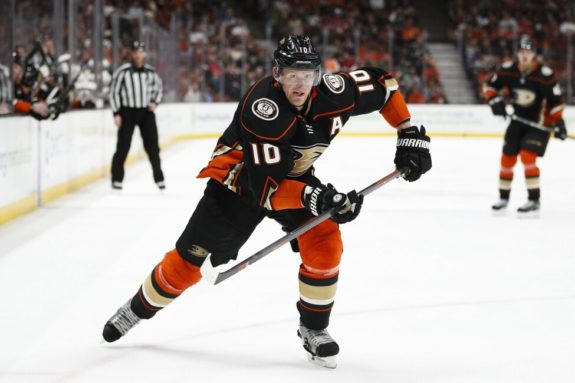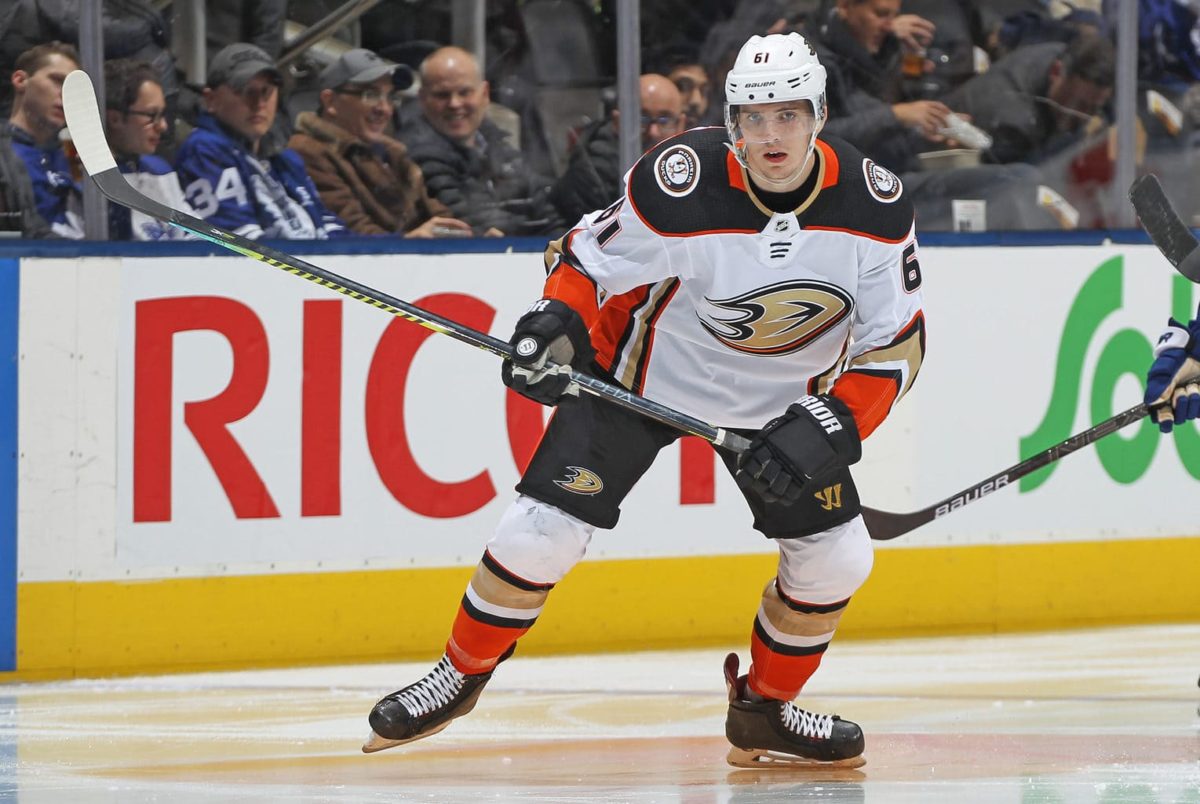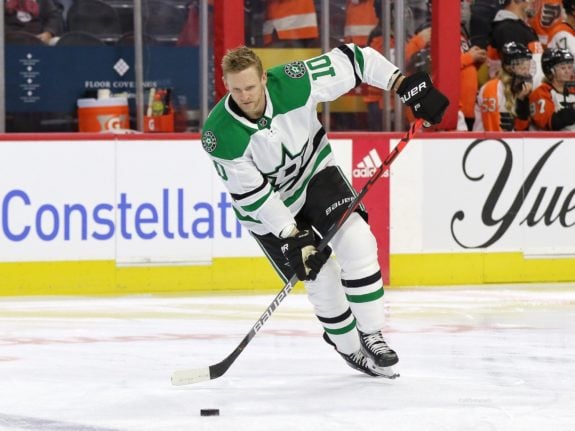It’s been well over a year since the Anaheim Ducks bought out Corey Perry’s contract, bringing an end to a 14-year partnership. Perry had spent the 2018-19 season labored by injuries and his scoring had steadily declined over the past several seasons.

With a crop of fresh faces looking to break into the lineup, general manager Bob Murray saw the former Hart Trophy winner as expendable due to a combination of age, injuries and sizable contract. However, buying out the Triple Gold Club member was a mistake.
Young Guns Failed to Impress
The jettisoning of Perry wouldn’t have looked quite as bad if the youngsters who replaced him in the lineup had made an impact. Unfortunately, that wasn’t the case as the Ducks finished 26th in goals for (187) just one season removed from finishing worst in the league in this category.
The trio of Max Jones, Troy Terry and Sam Steel combined for only 18 goals and none of their offensive point shares (OPS), an estimate of the number of points contributed by a player due to his offense, was above 1.0. Steel and Terry checked in at 0.1 and Jones actually registered a negative OPS, with -0.3.

Max Jones, Anaheim Ducks (Jess Starr/The Hockey Writers) 
Troy Terry, Anaheim Ducks (Photo by Claus Andersen/Getty Images) 
Sam Steel, Anaheim Ducks (Jess Starr/The Hockey Writers)
While Perry wasn’t much better with a 0.5 OPS, he actually contributed more on defense with a 1.0 defensive point shares (DPS). Steel, Terry and Jones all failed to reach a DPS of 1.0 or more, with Jones coming the closest at 0.8.
Related: 11 NHL Teams Without a Stanley Cup
Of course, Perry is a much more experienced player and should be expected to perform better than a triplet of young players. However, the inability of three players to replace the offensive production of one player is startling, especially considering that Perry was out for five months the previous season and still registered a 0.3 OPS.
Lack of Veteran Presence
The Ducks have been in a “retool” over the last couple of seasons, so it made sense to replace someone who was older and injury-prone in Perry. But getting rid of Perry also meant getting rid of one of the leaders and veteran players on the team. With the departures of Francois Beauchemin and Kevin Bieksa in recent seasons and Ryan Kesler indefinitely on the shelf, there was a dearth of leaders in the Ducks’ locker room.
Murray lamented the fact that he stayed out of the locker room too much during Dallas Eakins’s first season as Ducks head coach, saying that the accountability in the group needs to change and that he’s tired of the excuses being made for the team. (from ‘Ducks GM Bob Murray bluntly says no excuses next season,’ The Orange County Register, 06/03/2020)
Salary Cap Complications
With Perry set to make $8.625 million in 2019-20 and 2020-21 and not playing at a standard high enough to justify that salary, one can’t fault Murray for wanting to shed some salary in order to add more pieces and give other players a chance to replace Perry’s production at a much cheaper price. Buying out the winger’s contract meant a small $2.625 million cap hit for the 2019-20 season.

However, the 2020-21 season will see Perry’s cap hit due to the buyout rise to $6.625 million. This creates a large obstacle for Murray to navigate, especially in a flat salary cap era now due to COVID-19. The Ducks currently have $2.80 million in cap space available and that number will surely raise once Kesler is placed on LTIR and Patrick Eaves officially comes off the books.
While Ryan Miller and Kiefer Sherwood are still free agents, they should come fairly cheap, leaving the Ducks with some wiggle room ahead of free agency. But don’t expect them to make a move once the market opens up. Murray has never been one to spend big bucks in free agency and that shouldn’t change at all in an unprecedented time like this.
Playoff Perry
Though his goalscoring and playmaking abilities have tapered off as the injuries have accumulated, Perry still holds more playoff experience than a majority of players in the NHL and especially holds more experience than most players on the Ducks.
Only Ryan Getzlaf remains from the 2006-07 Stanley Cup Finals win and the rest of the current Ducks have limited playoff experience. Though the 2017-18 playoffs with Perry ended rather quickly for Anaheim, it never hurts to have more players with playoff experience, especially ones who can score timely goals.
In Perry’s first non-Ducks playoff appearance thus far, the Peterborough native has three points in six games with a -4 rating and 16.7 shooting percentage. Primarily playing on the third line with Roope Hintz and Jason Dickinson, Perry is averaging about 15 minutes per game and a little over a minute of power-play time per game as part of the second power-play unit. He also set up the game-winning goal in Game 2, threading a pass through the seam to a wide-open Jamie Oleksiak.
His 38th career playoff goal in Game 2 moved him past Getzlaf for a tie in 12th among active players and he is now 15th among active players in career playoff points. Most of Dallas’ power-play production has been because of Perry. His net-front presence —which had long been a staple during his time in Anaheim—has opened up opportunities for the Stars. (from ‘The Stars signed Corey Perry with the playoffs in mind. So far, it’s paying off.’ The Dallas Morning News, 08/14/20)
Old Dog, Different Tricks
Because lower-body injuries have sapped Perry’s speed, he’s been forced to adjust his game to a style that better suits him. In an era where speed is becoming an essential aspect of the game, one would think that Perry would be more of a liability than an asset.
However, that doesn’t appear to be the case. Because he can no longer outskate players, Perry has focused more on becoming a playmaker and it showed in his pass to Oleksiak. Perry also continues to be one of the most agitating players to play against and demonstrated that he can still get under the skin of today’s brightest stars when he faced off against Matthew Tkachuk—a player that many analysts liken to Perry in terms of agitation—in Game 1.
Related: A Look Back at the Anaheim Ducks’ 2011 Draft
The 35-year-old also remained relatively healthy this season, only missing time due to a broken foot suffered during training camp and a five-game suspension for elbowing Nashville Predators defenseman Ryan Ellis during the Winter Classic.
It can take players some time to settle in when joining a new team after spending so much time at their previous destination. Fellow new addition Joe Pavelski joined Dallas this past summer after 13 seasons with the San Jose Sharks and had just 10 more points than Perry in 10 more games. The pair is the most experienced playoff performers on the team and will be relied on heavily when the Stars’ backs are against the wall.
Reunion in Anaheim?
As much as Ducks fans would like to see the blonde-haired side of “The Twins” return to Orange County, it’s likely that the next time Perry returns to Honda Center will not be as a member of the Ducks once again. Sure, it would be a trip down memory lane if Perry were to come back and fly down the ice at Honda Center one more time next to Getzlaf.
But the plan that Murray and Eakins are currently crafting in Anaheim does not involve Perry. They made that clear when they decided to buy out the remainder of his contract instead of waiting to see whether Perry could return to full health and have an impact. There were upsides to making the move at the time, but with little to show in terms of progress to this point, this may be another mistake that Murray regrets.